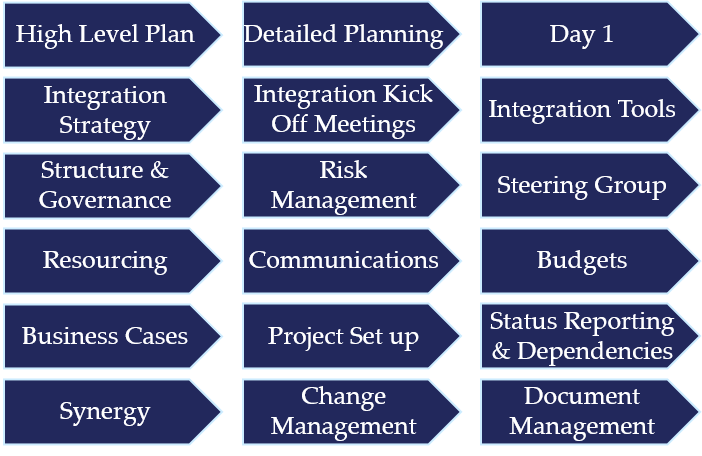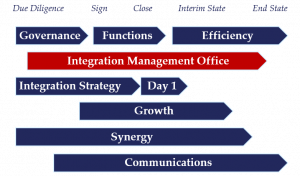The Integration Management Office (IMO) is the central hub for the planning, mobilisation and delivery of the integration.


Creating standardised templates and tools to aid workstreams, project and reporting, meaning less overall work to have a clearly run integration. Helping workstream, programme and projects set up plans with synergies, resource, budget, tracking, status reporting, milestones and activities.
The IMO will provide risk management and governance for all of the integration projects. Steering Groups initiated and reporting processes developed which includes document management and integration communication channels defined.
The IMO will work with Finance to agree budgets and signoff, with spend reporting. Set up the governance and facilitate meetings, prepare all agendas and materials ahead of meetings and track/follow-up on next steps following working sessions.
Deliverable synergies and potential hurdles to delivery have to be identified and managed. Inter-dependencies between integration teams also need to be identified and planned for.


The integration high level plan and its cascade to detailed planning and checklists need to be developed with integration teams and clear RACI structure communicated. Business case approvals and change management processes, systems to monitor progress and ensure synergy delivery is visible to business management (in business performance and results) all have to be created and owned by integration teams and the IMO.
The IMO will act as the liaison between workstreams, mapping and raising issues and inter-dependencies to help the smooth running of the integration, connecting people and work where needed.
The integration management office centralises and integrates the following functionalities:
High Level Integration Plan
Put in place a high level plan to kick of what is needed, by when and the amount of time, effort and resource it might take. This can then be signed off in principle by the steering group and more detailed plans can be kicked off. If you don’t know what needs doing, how can it be agreed.
Detailed Integration Planning
Each of the functional plans need to be kicked off, using our high level check list and then our detailed checklist. Plans are created, reviewed, then costed to ensure they fit the deal rational, budgets and synergies. Then checked against each other to ensure the inter-dependencies are understood and nothing falls through the gaps.
Good, detailed workstream plans result in better integrations. But building comprehensive plans takes time. Failure to plan correctly can lead to deals failing to maximise deal value.
Each functional workstream should create detailed plans with tasks, resources, due dates, and dependencies. These plans will evolve over time as we find out more information and know more details.
The IMO should work with each of the functional workstreams to ensure the correct level of detail and review each for consistency and fullness. Pointing out dependencies with other area’s and understanding action and resource gaps.
Resource the Integration
Put resource in place to get the integration planning going, and continue to plan and monitor resource as we go through the integration.
M&A Integration Governance
We need to have the structure around the integration for each team and how they will interact with each other? How should the integration structure interact with the business structure? Who will make decisions and release budget? What roll with the steering group play?
Meeting for all the different workstream and cross workstream parties need to be set up, documents maintained and meeting prepped for.
Integration Steering Group meetings
Reporting and tracking into the steering group, needs to be set up early with timing that fits the deal. This may change post deal. There will be an overarching steering group and then other groups at each level often for each workstream.
Ensure Day 1 plan is in place
A rapid understanding of the key issues that will be faced on Day 1 and an understanding of how long those things may take to put in place. Focus time and effort on the critical path work and get going. Then take a step back and gain a complete and detailed understanding of the business needs for Day 1 together with look and feel you want for the Day 1.
Will the business keep running? Will the lights stay on? What will customers see, think, feel, want? What will competitors do? Focus on employee during Day 1?
Plan and prepare.
M&A Integration Communications Planning
The IMO is the central planning place that has a full understanding of what is going on, sight of all plans, timings and budgets. This needs to be worked hand in hand with communications to ensure changes are understood and communications plans ready. Plans are to be put in place not just for the deal and Day 1 but all the functional and business integration plans across the timescales of the integration.
Structure
Integration is best managed by a Steering Committee that advises an Integration Management Office (IMO) that is responsible for planning and implementing the integration. The integration work is performed by each functional area (Human Resources, Finance, Operations, etc.).


The steering committee set strategic direction for Integration, define guiding principles, priorities & goals, sets the scope for transformation, sets expectations and needs to make key decisions.
The workstream and BU leads, ensure project management standard, drive project delivery, delivery the objectives on time and on budget, communicate with and report status to IMO, prepare & maintain business plans, project timelines and manage risks & issues. They ensure communications, performance metrics are hit, and manage change control, scope control and resource requirements.
Project set up
Synergies and change idea’s need to be split down into small plannable, deliverable chunks. Let’s call them projects. Each needs to be planned in full, with budgets, resource, milestones and deliverables. Set up, tracked and kept on track.
Project delivery management, interface and interdependency
management, cost and budget management, quality management, stakeholder management, performance management, document management, commercial management.
Review and control budgets
Ensure all budgets for projects are in pace and all projects stay on track for delivery of synergies and change needed.
Integration Risk Management
It is critical to understand the risks posed by the integration, business and the decisions we take. Having a risk workshop is a great idea, get all the risks out in the open and then have a plan to mitigate them. Tracking of the risks as we go through the deal can be done by the IMO and reported on. At timely intervals these should be updated with new risks that have popped up and smaller follow up risk workshops.
A number of risks have been identified, given the amount of work needed during deals, some or many of these are not catalogued, remembered, planed and resolved or mitigated correctly. It is often the case that issues that have been spotted or at least questioned, come back to bit us eventually. There is a large chunk of integration work associated with risk and their management.
Business Cases for Integration Projects
Help ensure business cases are in place, help with knowledge and resource, get them into the correct format for review, socialisation of business cases, check they fit with the plans, get them approved. Check the numbers add up to the deal business case – i.e. costs & synergies are being hit.
A Business Case (or project charter) often includes:
- Project purpose/justification
- Measurable project objectives
- High-level requirements
- Assumptions and constraints
- High level project description and boundaries
- High level risks
- Summary budget & milestones
- Initial stakeholder list
- Project approval requirements
- Assigned project manager
- Name and authority of the sponsor
- Financials
- Costs, profit or margin increase
- IRR calculations
- Hurdle rates for project approvals
- Timing of spend with stage gate approvals built in
Integration Kick off Meeting
Launch workshops can set the tone for the integration and steer us towards success. It is usually the first cross company event where people will meet face to face, often preceded by a managers meeting.
The workshop may include, an explanation of the deal rational, a general mapping of each company, integration strategy and expectation, the integration structure, explanation of the IMO work, and functional break out sessions to discuss integration work and Day 1 actions. Risks should be flagged and noted, delegates should leave with a clear understanding of their next steps and actions.
Synergy


Once current ways of working (and cost of delivery) are understood and the long-term strategy for the business post integration is understood, synergies can be identified, high level values developed and allocated to streams (function, divisions, businesses and countries).
Streams can then prepare individual Business Cases for review and approval via the IMO to ensure they are challenging, achievable, and when consolidated, support the high level values.
Delivery of synergy projects can be complex and you must understand how early decisions affect them longer term. Therefore, a robust and accurate tracking and reporting process (including a reconciliation to business performance reporting) within the internal control framework must be implemented to ensure that delivery is kept on track (or additional support provided if slippage occurs). To support this a constant review of potential additional synergies should be part of the framework.
Agreed Plans often include:
- Baselining for scope, work, costs
- Project scope (what is in and out)
- Actionable plan (with resource, costs, milestones, timelines)
- QHSSE plan
- HR plan
- Communications plan
- Cost plan
- Risk management plan
- Procurement plan
- Process improvement plan
- Tool, templates, checklists, policies, procedures, methodology
- Tracking, project management, governance.
- Deliverable list
Integration Strategy
What do you want the integration to deliver? A “light” integration where both businesses continue to develop operations separately due possibly to significant product and market differences (vertical acquisition of a supplier or customer) can still deliver value by understanding each business’s maturity model and strategy for development. Whether it is a “light” or full integration the maturity models and the future strategic vision for both businesses and the combined business must be understood to ensure planning will deliver the desired end point.
Once we have a clear detailed understanding of current ways of working for the businesses and details of the end point, the IMO can ensure that there is a sound business case and that planning and timing will deliver it. Interim scenarios for Day 1, Day 90 and Day 180 can be prepared and road maps, milestones and potential roadblocks to delivery designed/assessed.
The medium and long-term strategy for the business must be robust under challenge, fit for where the business wants to be. An acquisition may be part of the strategy but, may also provide new opportunities for the business to grow and become more profitable, if current and desired future ways of working are not understood, mapped and reviewed, integration value may be unrealised.
Change Management
All the functional and business unit plans need to be checked for change management.
Document Management
Documents need to be managed to an appropriate level given the size and complexity of the deal to enable good decision making, tracking and delivery. Deals are a one off item and appropriate documentation is needed for finance to track different types of spend and timing of them.
Rolling out processes and tools
During the early phases of integration, the IMO will introduce common processes, tools, and templates to ensure good coordination and comparability. The IMO will support the functions and business and manager by exception though regular status, tracking and dependency reporting.
Status reporting
Periodic report on workstreams, projects, synergies, costs, risks and solutions. Using standard reporting templates showing milestones, decisions to be made, issues to be resolved, and cross-functional dependencies to be managed.
Inter-dependencies
Help understand the dependencies between projects and areas, smooth the way to successful delivery. There are many cross workstream dependencies which need to be tracked and flagged, some can be small but others can cause catastrophic devastation if forgotten about.
A dependency is a need by one functional on another function. Usually the first area struggles to move forward in their planning or work until the other area has sorted something out for them. Managing dependencies across functions can be complex, confusing, and time-consuming. Often this is as simple as keeping a dependency log but if not run well, they dependencies can cause serious issue to delivery.
M&A Integration Tools
There are a number of tools we use which fit along side the chunks of work discussed in this document




